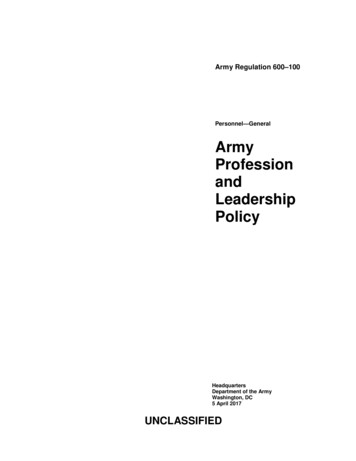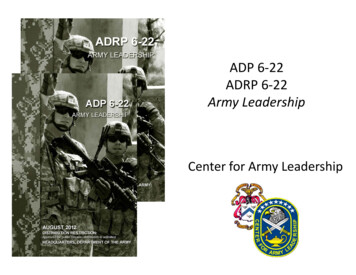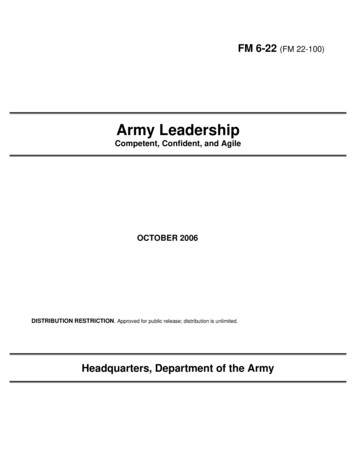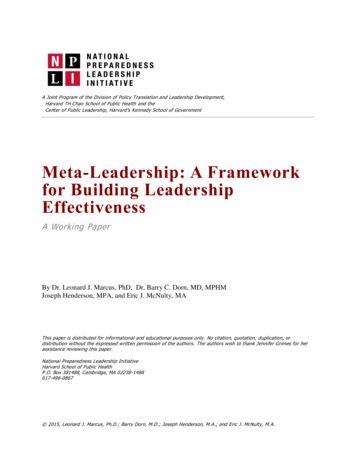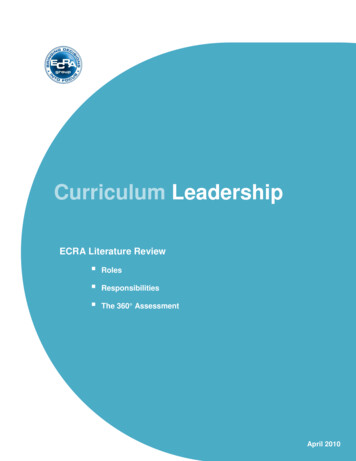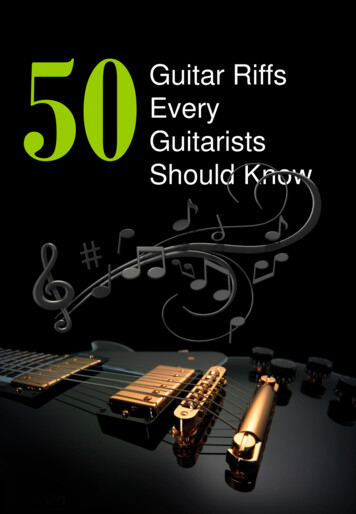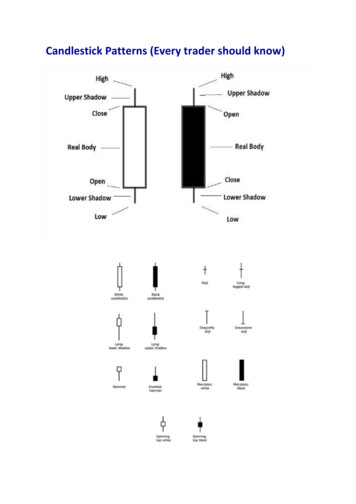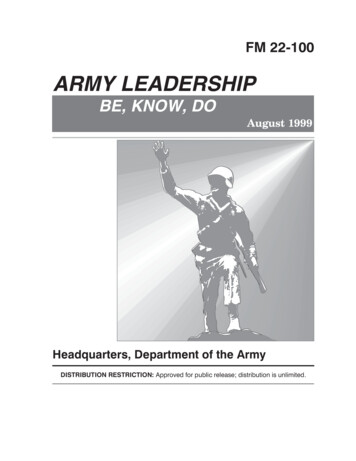
Transcription
FM 22-100ARMY LEADERSHIPBE, KNOW, DOAugust 1999Headquarters, Department of the ArmyDISTRIBUTION RESTRICTION: Approved for public release; distribution is unlimited.
*FM 22-100Field ManualHeadquartersNo. 22-100Department of the ArmyWashington, DC, 31 August 1999Army LeadershipContentsPageExamples .vPreface.viiPART ONE: THE LEADER, LEADERSHIP, AND THE HUMAN DIMENSIONCHAPTER 1THE ARMY LEADERSHIP FRAMEWORK .1-2Leadership Defined .1-4BE, KNOW, DO .1-6Levels of Leadership.1-10Leaders of Leaders.1-13Leadership and Command .1-14Subordinates .1-15The Payoff: Excellence .1-17Summary .1-19CHAPTER 2THE LEADER AND LEADERSHIP: WHAT THE LEADER MUST BE,KNOW, AND DO.2-1CHARACTER: WHAT A LEADER MUST BE.2-2Army Values.2-2Leader Attributes .2-10Focus on Character.2-19Section ISection IISection IIICOMPETENCE: WHAT A LEADER MUST KNOW .2-24LEADERSHIP: WHAT A LEADER MUST DO.2-26Influencing .2-27Operating.2-27Improving.2-28SUMMARY .2-28
CHAPTER 3THE HUMAN DIMENSION.3-1People, the Team, and the Institution .3-1Combat Stress .3-6The Stress of Change.3-8Climate and Culture.3-12Leadership Styles .3-15Intended and Unintended Consequences.3-18Summary .3-19PART TWO: DIRECT LEADERSHIPCHAPTER 4DIRECT LEADERSHIP SKILLS .4-2Interpersonal Skills .4-2Conceptual Skills.4-6Technical Skills .4-11Tactical Skills .4-12Summary .4-14CHAPTER 5DIRECT LEADERSHIP ACTIONS .5-1Influencing Actions .5-1Operating Actions.5-8Improving Actions.5-13Summary .5-27PART THREE: ORGANIZATIONAL AND STRATEGIC LEADERSHIPCHAPTER 6Section IORGANIZATIONAL LEADERSHIP.6-1WHAT IT TAKES TO LEAD ORGANIZATIONS—SKILLS .6-3Interpersonal Skills .6-3Conceptual Skills.6-5Technical Skills .6-9Tactical Skills .6-10Section IIWHAT IT TAKES TO LEAD ORGANIZATIONS—ACTIONS.6-12Influencing Actions .6-12Operating Actions.6-18Improving Actions.6-25Section IIIA HISTORICAL PERSPECTIVE OF ORGANIZATIONALLEADERSHIP—GENERAL RIDGWAY IN KOREA .6-29SUMMARY .6-32CHAPTER 7Section ISTRATEGIC LEADERSHIP.7-1STRATEGIC LEADERSHIP SKILLS .7-2Interpersonal Skills .7-2Conceptual Skills.7-7
ContentsTechnical Skills .7-10Section IISTRATEGIC LEADERSHIP ACTIONS .7-13Influencing Actions .7-13Operating Actions.7-18Improving Actions.7-22Section IIIA HISTORICAL PERSPECTIVE OF STRATEGIC LEADERSHIP—GENERAL OF THE ARMY MARSHALL DURING WORLD WAR II .7-26SUMMARY .7-28Appendix ARoles and Relationships .A-1Authority .A-3Responsibility and Accountability .A-4Communications and the Chain of Command .A-4The Noncommissioned Officer Support Channel .A-5DA Civilian Support .A-5Appendix BPerformance Indicators.B-1Values.B-2Attributes .B-3Skills .B-3Actions.B-4Appendix CDevelopmental Counseling.C-1The Leader’s Responsibilities.C-1The Leader as a Counselor .C-2Leader Counseling Skills .C-3The Leader’s Limitations.C-5Types of Developmental Counseling .C-7Approaches to Counseling .C-10Counseling Techniques .C-11The Counseling Process.C-12Summary.C-16The Developmental Counseling Form.C-17Appendix DA Leader Plan of Action and the ECAS .D-1Preparation of an ECAS .D-2Preparation of a Leader Plan of Action.D-4Appendix EAppendix FCharacter Development.E-1The Constitution of the United States .F-1Source Notes.Source Notes-1Glossary .Glossary-1Bibliography .Bibliography-1Index .Index-1Army Leadershipiii
ExamplesPageCOL Chamberlain at Gettysburg .1-8Small Unit Leaders’ Initiative in Normandy .1-16GEN Washington at Newburgh .2-3Duty in Korea .2-4GA Marshall Continues to Serve .2-6MSG Gordon and SFC Shughart in Somalia .2-8WO1 Thompson at My Lai .2-10The Will to Persevere.2-11The Quick Reaction Platoon .2-13GA Eisenhower Forms SHAEF.2-15Self-Control in Combat .2-17BG Jackson at First Bull Run.2-18Character and Prisoners .2-19The Battle of the Bulge .2-20GA Eisenhower’s Message .2-20The Qualification Report .2-22Soldiers Are Our Credentials.3-2The 96th Division on Leyte.3-4The K Company Visit .3-5Task Force Ranger in Somalia, 1993 .3-6Mix-up at the Crossroads .3-8“Superior Technology” .3-10Changing a Unit Climate—The New Squad Leader.3-13The Checking Account .4-3The Rusty Rifles Incident .4-5Finding the Real Problem.4-6Pulling Dragons’ Teeth .4-7The EFMB Test .4-10Technical Skill into Combat Power .4-11Task Force Kingston .4-13Solving a Training Problem.5-5An Implied Mission and Leader Plan of Action.5-9Brief Solutions, Not Problems .5-10Trust Earned .5-19Replacements in the ETO.5-22
PageReception on Christmas Eve .5-22SGT York .5-24Knowing Your People .6-4GEN Grant and the End of the Civil War.6-6DA Civilian Support to Desert Shield.6-8Innovative Reorganization .6-8GEN Grant at Vicksburg .6-11The Commander’s Notebook .6-14The 505th Parachute Infantry Regiment at Normandy.6-18The “Paperwork Purge” .6-20Allied Command During the Battle of the Bulge.7-5Strategic Flexibility in Haiti .7-9Show of Force in the Philippines.7-12Combat Power from a Good Idea.7-14The D-Day Decision .7-16Multinational Resource Allocation .7-19World War II Strategic Assessment .7-22Change After Vietnam.7-25
PrefaceThe Army consists of the active component, Army National Guard, Army Reserve,and Department of the Army (DA) civilians. It’s the world’s premier land combatforce—a full-spectrum force trained and ready to answer the nation’s call. TheArmy’s foundation is confident and competent leaders of character. This manual isaddressed to them and to those who train and develop them.PURPOSEFM 22-100 is a single-source reference for all Army leaders. Its purpose is threefold: To provide leadership doctrine for meeting mission requirements under all condi tions. To establish a unified leadership theory for all Army leaders: military and civilian,active and reserve, officer and enlisted. To provide a comprehensive and adaptable leadership resource for the Army of the21st century.As the capstone leadership manual for the Army, FM 22-100 establishes the Army’sleadership doctrine, the fundamental principles by which Army leaders act to accom plish the mission and take care of their people. The doctrine discusses how Army val ues form the basis of character. In addition, it links a suite of instruments,publications, and initiatives that the Army uses to develop leaders. Among theseare— AR 600-100, which establishes the basis for leader development doctrine andtraining. DA Pam 350-58, which describes the Army’s leader development model. DA Pam 600-3, which discusses qualification criteria and outlines developmentand career management programs for commissioned officers. DA Pam 600-11, which discusses qualification criteria and outlines developmentand career management programs for warrant officers. DA Pam 600-25, which discusses noncommissioned officer (NCO) career develop ment. DA Pam
The Army leadership framework brings together many existing leadership concepts by establishing leadership dimensions and showing how they relate to each other. Solidly based on BE, KNOW, DO—that is, character, competence, and action—the Army leadership frame

